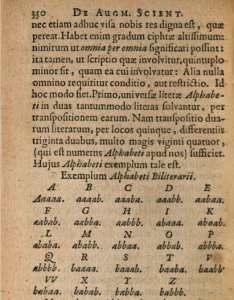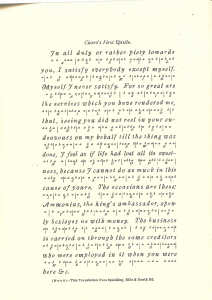By Kristin Davis (Vanderbilt University)
William Shakespeare has for centuries been considered one of the greatest literary figures of all time, but a secret cipher hidden within the very pages of his plays may tell an exceedingly different story, one of forbidden marriages, a forgotten prince, and most of all, the genius of one man: Francis Bacon.
Born in sixteenth century England, Sir Francis Bacon was not only Lord Chancellor of England under James I, but was also a brilliant philosopher (British Broadcasting Company, 2012). Though not appreciated in his time, one of Bacon’s greatest achievements was a simple cipher he incorporated in his written works called the Baconian cipher (Sherman, 2010). The Baconian cipher does not possess great strength against decryption; instead its immense power and intrigue resides in its ability to make mystery lie, or appear to lie, in everything.
 While most ciphers’ strengths dwell in the difficulty of finding the key to unlock a pattern, the Baconian cipher’s power lies in the challenge of uncovering its existence (Sherman, 2010). The cipher is only a simple substitution cipher in which one letter (or group of letters) stands for one other letter. The letters never change what they stand for as long as the same key is used throughout a message (Worley III, 2003). The Baconian cipher employs this substitution method by assigning a string of five letters consisting of only a’s and b’s to each letter in the alphabet. The arrangement of a’s and b’s in the five letter sequence determines the alphabet letter in the message (Worley III, 2003).
While most ciphers’ strengths dwell in the difficulty of finding the key to unlock a pattern, the Baconian cipher’s power lies in the challenge of uncovering its existence (Sherman, 2010). The cipher is only a simple substitution cipher in which one letter (or group of letters) stands for one other letter. The letters never change what they stand for as long as the same key is used throughout a message (Worley III, 2003). The Baconian cipher employs this substitution method by assigning a string of five letters consisting of only a’s and b’s to each letter in the alphabet. The arrangement of a’s and b’s in the five letter sequence determines the alphabet letter in the message (Worley III, 2003).
If a message contained only strings of a’s and b’s, it would be quite obvious to a cryptologist that some sort of cipher was used. Francis Bacon’s genius lies not in this simple substitution cipher, but in the fact that his cipher could be wielded to make, in Bacon’s own words, “anything mean anything” (Sherman, 2010). With the extra twist of steganography, which is concealing messages through deception, a-form and b-form can be two types of anything, from black and white to plus and minus, not just text (Sherman, 2010).
In Bacon’s traditional method, he replaced a’s and b’s with a-form fonts and b-form fonts (Worley III, 2003). For example, an enciphered message would be created by writing a seemingly innocuous message then changing the font of the letters so that bolded letters represent a’s and italicized letters represent b’s (Worley III, 2003). To decipher the message, the recipient would identify the a-forms and b-forms and use Bacon’s key to determine the alphabet letter signified by the string of five forms.
|
Innocuous Message |
This is a Baconian cipher text |
|
Cipher Text |
Codes C / O / D / E / S aaaba/abbab/aaabb/aabaa/baaab |
|
Process of Enciphering |
aaaba/abbab/aaabb/aabaa/baaab This i/s a Bac/onian/ ciphe/r text |
|
Steganography |
This is a Baconian cipher text |
Being at its base only a substitution cipher, the method needed to break the plain cipher requires only knowledge of letter frequencies in the English language (Singh). To break the cipher, one first needs to accomplish the most challenging task of identifying the cipher is being employed. Next, one separates the letters of the message into groups of five and identifies the pattern of a-forms and b-forms. Because one five-letter group stands for one alphabet letter, one looks up the known frequencies of letters in English and matches them up with the frequency each five-letter group appears in the message (Worley III, 2003). For example, if the pattern “aabba” appears twelve percent of the time in the message, and the letter that appears twelve percent of the time in English is “e,” it can be inferred that “aabba” stands for “e.” Though cryptanalysis seems simple, this assumes the cryptologist first knows the cipher exists. Without a careful eye, a cryptologist could pass over the cipher not knowing its existence or spend years fruitlessly and frustratingly looking for something that was never there.
 The unique complexity and mystery of the Baconian cipher has enticed cryptologists for generations to find patterns in chaos and hidden messages in everything from poetry, music, and most famously, Shakespeare. Though Bacon’s cipher was never adopted for military purposes, and Bacon only created it for his own amusement, his cipher took the literary world by storm (Sherman, 2010). Much like seeing pictures in the clouds or faces on the moon, cryptography enthusiasts began to see hidden a-form and b-form letters in everything.
The unique complexity and mystery of the Baconian cipher has enticed cryptologists for generations to find patterns in chaos and hidden messages in everything from poetry, music, and most famously, Shakespeare. Though Bacon’s cipher was never adopted for military purposes, and Bacon only created it for his own amusement, his cipher took the literary world by storm (Sherman, 2010). Much like seeing pictures in the clouds or faces on the moon, cryptography enthusiasts began to see hidden a-form and b-form letters in everything.
One of the most famous results of Bacon’s cipher was widely considered “The Greatest of Literary Problems” (Sherman, 2010). After Shakespeare’s plays were written, literary analysts began to doubt that William Shakespeare of Stratford had been the true playwright (Sherman, 2010). The anti-Stratforians, as they called themselves, argued that Shakespeare, the uneducated, barely literate peasant, could not have produced such grand works (Baxter, 1915, p. 548). A promising alternative to the Stratford Shakespeare was Sir Francis Bacon (Sherman, 2010). After the discovery of De Augmentis, in which Bacon himself explains the workings of his cipher explicitly, literary analysts scoured the Shakespeare plays for the Baconian cipher (Friedman, 1957, p. 189).
In the early twentieth century, a prominent figure in the search, schoolteacher Elizabeth Wells Gallup, claimed to have broken the Baconian cipher found in the Shakespeare plays by analyzing the original folios to produce “alphabet classifiers” that determined whether a letter was an a-form or b-form (Sherman, 2010). Gallup deciphered pieces of text that seemed to indicate that Francis Bacon not only wrote the works historically contributed to Shakespeare, but also works of Spenser, Peele and Green, and Marlowe (Gallup, 1910, p. 17). Most consequential of all was that the cipher text claimed that the Virgin Queen Elizabeth I was no virgin at all, but actually the mother of Francis Bacon (Gallup, 1910, p. 6). This history-altering revelation meant that Bacon would have been the rightful heir to the throne and therefore the last Tudor, not Elizabeth (Gallup, 1910, p. 6). During Elizabeth Gallup’s time, even well respected thinkers such as Mark Twain, Walt Whitman, Sigmund Freud, Henry James, Henry Miller, and Helen Keller were “Baconians” (Sherman, 2010). As Gallup’s theories generated interest within the general public, millionaire businessman George Fabyan organized a group of cryptographers who worked on, as Fabyan explained, “wrestling from Nature, her secrets” (Sherman, 2010).
Fabyan not only greatly expanded Gallup’s work on the Shakespeare ciphers, but also more importantly introduced a young William Friedman to Francis Bacon’s ciphers (Sherman, 2010). Starting as an assistant to Gallup, Friedman began to doubt the methods used to decipher the texts (Friedman, 1957, p. 210). William Friedman and his wife, Elizebeth Friedman, began to notice inconsistencies in Gallup’s method of determining a-form letters and b-form letters (Friedman, 1957, p. 210). Friedman observed that often only Gallup would be able to see the differences in fonts and would often change her methods to “fix errors” to make the cipher text intelligible (Friedman, 1957, p. 210). Though Friedman would later disprove Gallup’s methods altogether and determine the Shakespeare project futile, this first exposure to the world of ciphers created the man that would soon go on to be one of history’s greatest cryptographers (Sherman, 2010).
Friedman was such a proponent to the development of cryptography that he not only coined the term “cryptanalysis,” but also served as chief cryptographer of United States for more than thirty years, co-invented the US Army’s best cipher machine, broke the Japanese PURPLE code in World War II, and wrote papers that gave cryptography its mathematical foundations (Sherman, 2010). Throughout his life, Friedman remained fascinated by the Baconian cipher that began his career.
While a colonel in the army, Friedman kept on his desk a picture of soldiers to whom he had just taught a class about cryptography. Though at first the picture seems like any other war memento, on closer examination one might notice how some soldiers are not looking at the camera. An even sharper eye might notice that the pattern of looking towards and away from the camera spells out Friedman’s favorite Baconian axiom: knowledge is power (Sherman, 2010).
Though Bacon may not have enciphered messages that he authored Shakespeare’s plays or was the son on Queen Elizabeth I, Bacon’s cipher and the reactions to it changed not only the field of cryptography, but also the future of technology. Bacon, with his two-letter alphabet, was, according to the Center Cryptologic History, “the inventor of the binary code that forms the basis of modern … computers” (Sherman, 2010). Though the authorship mystery of Shakespeare may never be solved, Bacon’s cipher created the career of one of the greatest cryptographers of all time and formed the basis for binary code, the language of computers. Francis Bacon’s ability to hide mystery within the mundane forced others to look past the obvious to appreciate the mystery within everyday life.
This post was first published in December 2012. This post is part of a series of essays on the history of cryptography produced by students at Vanderbilt University. The students wrote these essays for an assignment in a first-year writing seminar taught by mathematics instructor Derek Bruff. The essays are shared here, in part, to give the students an authentic and specific audience for their writing. For more information on this cryptography seminar, see the course blog.
Did you enjoy this post? If so, check back for more Cryptography posts November 17th-November 21st.
Works Cited
Baxter, J. P. (1915). The Greatest of Literary Problems. New York: Houghton Mifflin Company. British Broadcasting Company. (2012). Francis Bacon. Retrieved October 27, 2012, http://www.bbc.co.uk/history/historic_figures/bacon_francis.shtml.
Friedman, W. F. (1957). Shakespearean Ciphers Examined. Cambridge: Cambridge University Press.
Gallup, E. W. (1910). Concerning the Bi-literal Cypher of Sir Francis Bacon: Pros and Cons of the Controversy. London, England: Howard Publishing Company.
Sherman, W. H. (2010). How to Make Anything Signify Anything. Cabinet (40).
Singh, S. (n.d.). Substitution Ciphers. Retrieved October 27, 2012, from The Black Chamber: http://www.simonsingh.net/The_Black_Chamber/crackingsubstitution.html.
Worley III, G. G. (2003, February 26). Baconian Cipher. Retrieved October 25, 2012, from Computer Science at the University of Central Florida: http://www.cs.ucf.edu/~gworley/files/baconian_cipher.txt
Pictures
Bacon, F. (1623). De Augmentis Scientiarum Libri IX. London: In officina Ioannis Hauiland.
Bacon, F., Spedding, J., Ellis, R. L., & Heath, D. D. (1882). The Works of Francis Bacon. London: Longman.
